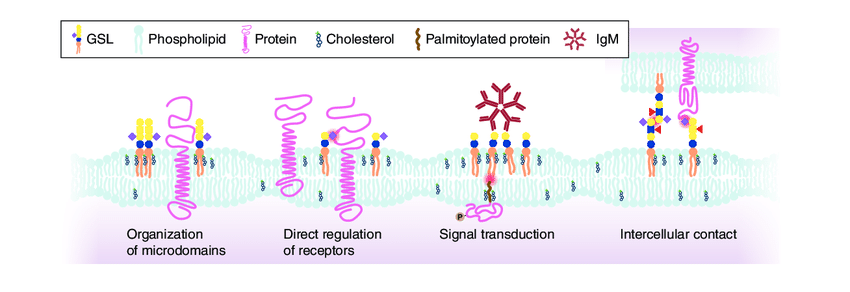Glycosphingolipid Microarray Service
- Cell Function and Signaling Studies
- Disease Mechanism and Biomarker Discovery
- Infection and Pathogen Recognition
- Drug Development and Target Validation
Glycosphingolipid Microarray Service is a specialized analytical service based on microarray technology that systematically evaluates the binding characteristics and recognition profiles between structurally diverse glycosphingolipids (GSLs) and various biomolecules such as antibodies, pathogen proteins, and receptor molecules. By constructing high-density GSL arrays, this service efficiently reveals the functional roles of GSLs in processes like signal regulation, pathogen recognition, and immune modulation.
Glycosphingolipids are key glycosylated lipid molecules located on the cell membrane, consisting of a hydrophobic sphingolipid backbone and an extracellular glycan chain. They play essential roles in biological processes such as cell recognition, signal transduction, immune response, pathogen attachment, and neural development. In pathological conditions such as cancer, autoimmune diseases, viral infections, and neurological disorders, both the expression patterns and glycan modifications of GSLs often undergo significant changes, making them highly valuable as biomarkers and therapeutic targets. With the rise of glycolipidomics, high-throughput and systematic analysis of GSL–biomolecule interactions has become a powerful tool for uncovering their functional mechanisms. The Glycosphingolipid Microarray provides such a high-throughput platform, enabling rapid profiling of GSL binding interactions to explore their roles in immune regulation, signaling pathways, cell recognition, and disease pathogenesis.
MtoZ Biolabs offers Glycosphingolipid Microarray Service to perform high-throughput screening and analysis of interactions between various GSLs and diverse biomolecules. This service supports detailed characterization of GSL binding specificity, affinity, and functional roles, facilitating research in GSL-mediated biological processes, biomarker discovery, and pathogen recognition mechanisms. We support customized array designs and parallel multi-sample analysis, making this service suitable for a wide range of applications in basic research, translational medicine, and biopharmaceutical development.

Sigal DS. et al. Future Oncol. 2022.
Figure 1. Glycosphingolipid functions.
Analysis Workflow
The main analytical workflow of the Glycosphingolipid Microarray Service is as follows:
1. Glycosphingolipid Selection and Array Construction
Naturally derived or synthetically produced glycosphingolipids are selected and immobilized to construct a high-density array with well-defined structures and orderly arrangement.
2. Preparation and Incubation of Recognition Molecules
Labeled recognition molecules (such as antibodies, lectins, receptor proteins, or pathogen factors) are incubated with the glycosphingolipid array under controlled conditions.
3. Signal Detection and Acquisition
High-sensitivity fluorescence or enzyme-based detection systems are used to scan the array and record the binding signal intensity at each spot.
4. Data Processing and Result Output
Raw data are normalized and subjected to statistical analysis. Binding profiles, heatmaps, and functional annotations are generated and delivered in a visualized analytical report.
Service Advantages
High-Throughput Screening: Enables simultaneous analysis of interactions between multiple glycosphingolipids and various biomolecules, allowing rapid profiling of binding specificity and recognition patterns.
Low Sample Requirement: Requires only minimal amounts of glycosphingolipids and recognition molecules per assay, making it suitable for rare or limited clinical and experimental samples.
Compatible with Diverse Recognition Molecules: Supports detection of antibodies, lectins, pathogen proteins, toxins, and receptor molecules, offering broad and flexible applications.
Customizable Service Support: Offers personalized array design, data analysis, and other tailored services to meet the specific needs of different research projects.
Sample Submission Suggestions
This service supports a variety of sample types. To ensure optimal experimental outcomes, we recommend discussing the project background and sample details with MtoZ Biolabs’ technical team prior to submission. A detailed and tailored sample preparation and shipping guide will be provided.
Applications
Application examples of the Glycosphingolipid Microarray Service:
Investigate the regulatory roles of GSLs in processes such as cell adhesion, migration, and differentiation, and uncover their critical functions in cell communication and immune modulation.
Identify GSL molecules associated with cancer, neurological disorders, and immune dysregulation to support early disease detection, biomarker screening, and molecular subtyping.
Study the role of GSLs as receptors for viruses, bacteria, and other pathogens to provide mechanistic insights for anti-infective therapy and vaccine design.
Screen GSL-binding targets with therapeutic potential and evaluate the binding efficiency and functional activity of GSL-targeted drug candidates.
Related Services
How to order?







